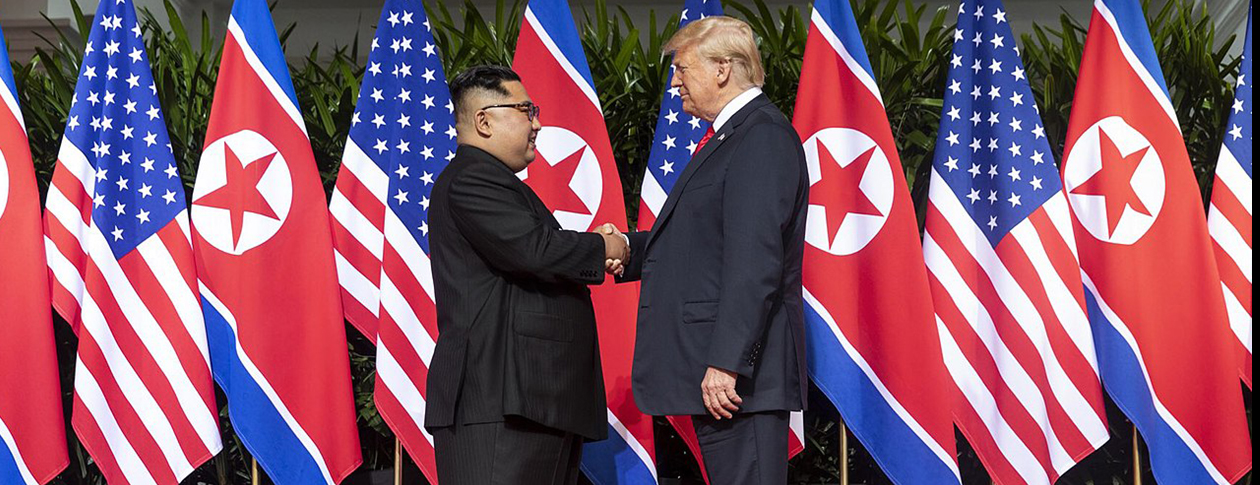Everything is very simple in war, but the simplest thing is still very difficult.” (Carl von Clausewitz, On War)
Donald Trump plans to meet with North Korean leader Kim Jong-un sometime toward the end of February. From the American president’s standpoint, the continuing rationale of this second summit (the first was held in Singapore on June 12, 2018) will be to bring about North Korean “denuclearization.” To the extent that the term implies a substantial or even total removal of nuclear weapons by Pyongyang, this presidential goal is markedly ill-founded.
Testifying before Congress on January 29 this year, pertinent US intelligence chiefs expressly challenged and pointedly contradicted any such impractical goal.
Prudential US foreign policies require plausible objectives. Accordingly, the American president must think along more realistic lines of achieving long-term nuclear deterrence with this determined adversary. As the several US intelligence agency heads recently agreed, under no imaginable circumstances could it make strategic sense for North Korea to surrender its only tangible bases of global power.
During the upcoming negotiations, President Trump should take scrupulous care not to exaggerate America’s risk-benefit calculus. Such required diplomatic caution will derive in significant measure from the absence of historically comparable crises. To the extent that there has obviously never been a nuclear war, there could be no scientifically-acceptable way for Mr. Trump to ascertain the true probability of any US-North Korea nuclear conflict.
This unavoidable observation is sobering and stark, but it is also unequivocal. Meaningful mathematical probabilities must always be drawn from the determinable frequency of relevant past events. This does not mean that the American president’s senior strategists and counselors should steer clear of rendering clear-eyed assessments of applicable nuclear costs and risks (quite the contrary), but rather that any such assessments will have to be drawn from constantly shifting and sometimes indecipherable geopolitical trends.
There is more. President Trump should bear in mind that many or all of these continuously transforming and mutating developments will be impacted by “Cold War II,” an oppositional stance now well established with Russia, and also by certain related decisions and behaviors issuing directly from China. Similarly important will be the US president’s willingness to recognize consequential limits of “expert” military advice proffered by his senior military planners. This caveat is not due to any inherent intellectual inadequacies on the part of American generals, but because literally no person on earth has ever actually fought a nuclear war.
It follows, further, that such foreseeable limits on useful advice are presently irremediable.
Going forward with this rapidly approaching second summit, all major US strategic calculations will be fraught with both intersecting complexities and daunting uncertainties. Still, it will remain altogether necessary for President Donald Trump and his counselors to offer their very best available war estimations. Among prospectively causal factors – some of them overlapping, interdependent or authentically “synergistic” – the calculable risks of a nuclear war between Washington and Pyongyang will depend upon whether any such conflict would be intentional, unintentional, or accidental.
Such a demarcated tripartite distinction is not unwittingly precise; instead, it is indispensable to any hoped-for success in US nuclear war prediction and prevention.
There is more. In all North Korean summit-related circumstances, it will be necessary that competent US policy analysts systematically examine and suitably measure various dynamic configurations of nuclear risk. Expressed in game-theoretic parlance of formal military planning, these shifting configurations could present singly or one-at-a-time (the foreseeable best case for Washington), but they might also arise more-or-less suddenly, unexpectedly, with diffusiveness, or in multiple “cascades” of strategic complexity.
To properly understand such bewildering cascades will require well-developed and formidable analytic skills. Among other disqualifications, this will not be a job for the intellectually faint-hearted.
Even as Donald Trump and Kim Jong-un seem to be growing more comfortable with a “de-escalatory” second-phase of summit negotiations (“we fell in love” is exactly how the American president so charmingly put it), it is conceivable that neither party is actually paying sufficiently close attention to the specific and residual risks of unintentional nuclear war. Reliably, at least to this point in their ongoing summitry, each president would seem to be assuming the other’s complete rationality. After all, if there were no such mutual assumption, it would make no sense for either leader to negotiate further security accommodations with the other.
Deterrence must be the overriding US goal. But this goal is always contingent upon certain basic assumptions of enemy rationality. Are such assumptions realistically valid in this particular case of a potential war between nuclear powers? If President Trump, despite “falling in love” with Kim Jong-un, should sometime begin to fear enemy irrationality in Pyongyang, issuing any new threats of US retaliation might then make no convincing sense.
At that unprecedented stage, American national security could depend upon some presumptively ideal combinations of ballistic missile defense and defensive first strikes. By definition, determining such combinations would lack any decisional input from concrete historical circumstances.
In the conceivably worst case, the offensive military element could entail a narrowly situational or even comprehensive preemption, but at that manifestly late stage all previous hopes for bilateral reconciliation would already have become moot. There could then obtain no “ordinary” circumstances wherein a preemptive strike against an already nuclear adversary such as North Korea would be rational.
None of these difficult decisions could easily be reached. With the steadily expanding development of “hypersonic” nuclear weapons, figuring out optimal US policy combinations from one crisis to another could quickly become overwhelming. Though counterintuitive amid such anticipated complications, the plainly evident fact that one “player” (the US) is conspicuously “more powerful” than the other (North Korea) could prove to be irrelevant.
In all such foreseeable circumstances, there will be overlapping issues of law and strategy. Under international law, which remains an integral part of US law, the option of a selective or comprehensive defensive first-strike might be correctly characterized as “anticipatory self-defense.” But this is the case only if the American side could argue coherently and persuasively that the “danger posed” by North Korea was “imminent in point of time.” Such discernible “imminence” is specifically required by the authoritative standards of international law – that is, by criteria established after an 1837 naval incident famously called “The Caroline.”
Now, however, in the substantially more complicated nuclear age, offering aptly precise characterizations of “imminence” could prove densely problematic.
For the moment, it seems reasonable that Kim Jong-un would value his own personal life and that of his nation above any other imaginable preference or combination of preferences. He is visibly and technically rational, and thus remains plausibly subject to US nuclear deterrence. Nonetheless, it could still become very important for a negotiating American president to distinguish between authentic instances of enemy irrationality and deceptive instances of pretended or feigned enemy irrationality.
Is US President Trump up to such a challenging task?
In the past, Mr. Trump himself had praised pretended irrationality as a potentially useful US national security strategy. Apropos of this praise, his earlier “fire and fury” warnings (issued before he “fell in love” with Kim Jong-un) might have reflected a prospective “rationality of pretended irrationality” posture for the United States. Ultimately, for analytic purposes, such a posture could be adopted by either one or both sides.
Although neither side would likely seek a shooting war in some tangible form or other, either or both heads of state could still commit catastrophic errors in rendering their “synergistic” strategic calculations. Such grievous errors, by definition, would represent an unintended consequence of jointly competitive searches for “escalation dominance.” Arguably, such markedly crucial errors are more apt to occur in those circumstances where one or both presidents had first chosen to reignite hyperbolic verbal rhetoric.
Even in reassuringly calm periods of polite and congenial diplomatic discourse, however, major miscalculations, accidents or cyber-confusions could still rapidly accumulate.
What then?
In presumptively worst-case scenarios, negotiations gone wrong could result in a nuclear war.
There is more. An inadvertent nuclear war between Washington and Pyongyang could take place not only as the result of various misunderstandings or miscalculations between rational national leaders, but also as the unintended consequence (singly or synergistically) of mechanical, electrical, computer malfunctions, or of certain “hacking”-type interventions.
Inevitably, in any still-impending crisis between Washington and Pyongyang, each side will expectedly strive to maximize two critical goals simultaneously. These goals are (1) to dominate the dynamic and largely unpredictable process of nuclear crisis escalation; and (2) to achieve desired “escalation dominance” without sacrificing any vital national security obligations. In the final analysis, this second objective means preventing one’s own state and society from suffering any catastrophic or even existential harms.
This brings up a prior point concerning absolutely all obligatory assessments of relative military power. When President Trump, in an earlier verbal competition with Kim Jong-un, stated that the North Korean president may have his nuclear “button,” but that his own American “button” was impressively “bigger,” the US leader revealed a major military misunderstanding. Today, in the still advancing nuclear age, atomic superiority is potentially per se insignificant and could sometime lead the presumptively stronger nuclear adversary toward variously lethal expressions of diplomatic overconfidence. In essence, as Mr. Trump should now fully understand, even an enemy with a smaller “nuclear button” could inflict unimaginably grave harms upon the “stronger” United States and/or its close allies in Japan or South Korea.
This vital understanding must obtain as long as Kim Jong-un’s “inferior” nuclear arms are seeminglyinvulnerable to any American preemptions and are also seemingly capable of penetrating deployed ballistic missile defenses in the United States, Japan or South Korea. Because of the extraordinary harms generated by even low-yield nuclear weapons (recall that even the “small” 14-KT Hiroshima bomb produced almost 100,000 prompt fatalities), a small percentage or plainly tiny fraction of Kim’s “inferior” nuclear arsenal could and should appear unacceptably destructive in Washington, Tokyo or Seoul. Worth noting, too, is that in all of these critical dimensions of strategic judgment, the only reality that would actually figure in any ongoing adversarial calculations would be perceived reality.
The bottom line of all such informed assessments concerning a still-possible US-North Korea nuclear war is that underlying issues of contention and calculation are enormously complicated. Faced with such daunting measures of complexity – both operational and legal – each side must proceed in a fashion that is both purposeful and risk-averse. Although such prudent counsel may seem to run counter to assorted inter-linking obligations of “escalation dominance,” these upcoming negotiations are very deep and uncharted “waters.”
In all such turbulent “seas” of decisional uncertainty, aggressive over-confidence by President Trump or President Kim would have to be consciously avoided. Although everything at the upcoming summit may first appear “very simple,” even the simplest thing will still be “very difficult.” All in all, therefore, to appreciate the timeless wisdom of Carl von Clausewitz’ On War could offer a more promising summit outcome for Donald J. Trump and the United States.

























